Sarah Sundin's Blog, page 476
May 24, 2012
Book Beat - Stardust by Carla Stewart
 An eclectic cast of characters, a setting as rich as any character, the fascinating historical backdrop of the polio epidemics in the early 1950s, and Carla Stewart's lyrical writing make
Stardust
a winner of a novel.
An eclectic cast of characters, a setting as rich as any character, the fascinating historical backdrop of the polio epidemics in the early 1950s, and Carla Stewart's lyrical writing make
Stardust
a winner of a novel.Georgia Peyton has just lost her husband - first to another woman, and then to death. When a distant family member bequeathes the rundown Stardust tourist court to Georgia, she's determined to turn the place around. At first glance, Georgia seems to be another determined red-headed spitfire of a heroine, but her true strength is her enormous heart. She cares for her alcoholic former mother-in-law, who still believes her son walked on water. She gives a job to a mysterious drifter. She befriends an African-American family - something simply not done in 1952 Texas. And when her husband's mistress shows up at the Stardust, pregnant with his child, Georgia shows compassion in heartbreakingly generous ways. Georgia has the amazing ability to put aside her personal hurts and treat people as they should be treated - the essence of forgiveness.
The subtle and beautiful spiritual message elevates Stardust beyond mere story - but the story itself is excellent. The polio epidemic makes a dramatic and poignant backdrop. Most people nowadays have forgotten what a horrifying disease it was - be very thankful for the polio vaccine! The fascinating characters will please the reader of women's fiction, a sweet love story rewards the romantic's heart, and Carla Stewart's writing will delight any fan of the written word. I highly recommend this novel.
Just for fun, Carla is holding a Stardust Retro Giveaway on her blog through May 28! She's giving away a cute retro apron, a retro mixing bowl filled with Southern cooking ingredients, Mayhaw jelly, pralines, and a signed copy of Stardust!
Published on May 24, 2012 05:00
Today in World War II History
70 Years Ago—May 24, 1942: Germans launch offensive against Soviet partisans in Bryansk-Vyazma rail line area.
Published on May 24, 2012 03:00
May 23, 2012
Today in World War II History
 70 Years Ago—May 23, 1942: US Navy orders production of Grumman Hellcat fighter. San Francisco emergency vehicles requested not to use sirens due to confusion with air raids.
70 Years Ago—May 23, 1942: US Navy orders production of Grumman Hellcat fighter. San Francisco emergency vehicles requested not to use sirens due to confusion with air raids.
Published on May 23, 2012 03:00
May 22, 2012
Today in World War II History
70 Years Ago—May 22, 1942: Mexico declares war on Germany, Japan, and Italy after many ships lost to subs.
Published on May 22, 2012 03:00
May 21, 2012
The B-17 Flying Fortress, Part 2 - Crew
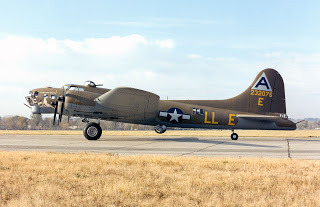 B-17G Shoo Shoo Baby at the US Air Force Museum, Dayton OH
B-17G Shoo Shoo Baby at the US Air Force Museum, Dayton OH
USAF PhotoFew World War II airplanes have captured the imagination like the Boeing B-17 Flying Fortress.
Springtime means the B-17s are on tour! Several organizations have beautifully restored B-17s that tour the country. For years, I've enjoyed walking through these planes, and last year I had the awesome privilege of flying in the Experimental Aircraft Association's Aluminum Overcast. You can read about my flight and watch a video here. If you'd like to see one of these gorgeous planes up close, please see the tour schedule for The Experimental Aircraft Association and The Collings Foundation. This is the second of a three-part series on the legendary Flying Fortress - a starring side character in my novels. Last week I talked about the plane and today about the crew.
Crew Loyalty
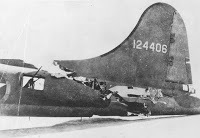 B-17F All-American
B-17F All-American
USAF Photo
Both the B-17 Flying Fortress and the B-24 Liberator were used by the United States Army Air Force as long-rage, high-altitude, four-engine heavy bombers. A friendly rivalry grew between crews of the "Fort" and the "Lib." On paper, the B-24 seems to be the winner, with a higher speed, larger bomb load, and longer range. But fans of the B-17 not only liked its graceful lines and the ability to fly at higher altitudes, but its ruggedness. While the B-24 had a tendency to break up when ditching at sea, the B-17 was more likely to stay intact, and the survival rate from ditching was far higher in the B-17.
The Flying Fortress could take lots of damage and still get the crew home. The photo to the left shows the All-American, a B-17F almost severed in half by a collision over Tunisia. The pilot compensated for the lost and damaged controls and brought the plane home. Miraculously, even the tail gunner survived. Numerous stories like this brought fierce loyalty from B-17 crews.
Over time, the B-24 became favored in the Pacific for its range and bomb load, while the B-17 became the heavy bomber of choice in the European Theater.
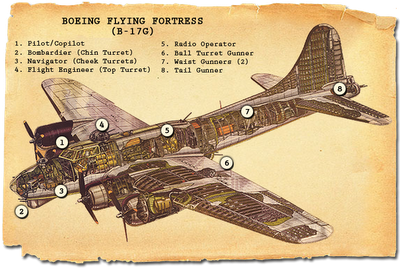 The Crew in the Cockpit
The Crew in the Cockpit
This cutaway view of a B-17G shows the postions of the ten crew members.
The pilot and copilot sat at position #1 in the cockpit. Both started as lieutenants. The pilot also served as crew commander, in charge of discipline and morale. The copilot assisted the pilot in flying the plane and could take control if the pilot was disabled. During a mission, the copilot took responsibility for interphone communications with the rest of the crew.
Just behind the pilots stood the flight engineer/top turret gunner (position #4). A technical sergeant, this man knew the plane's operating systems extremely well and took responsibility for repairs in flight. In combat he operated the top turret gun.
Crew in the Nose Compartment
The nose compartment was separated from the cockpit by a narrow crawlway. The navigator, a lieutenant, sat at a desk at position #3, where he carefully charted the plane's position and course using dead reckoning, pilotage, radio aids, and even celestial navigation. Although B-17s flew in large formations, each plane had to be able to find its way to the target and home if separated from the group. In combat, the navigator was responsible for the left cheek gun (in the B-17F) and for both cheek guns in later models of the B-17F and in the B-17G.
The bombardier also served in the nose compartment (position #2). A lieutenant, the bombardier was responsible for loading the bombs on the ground, arming the bombs in flight, and most importantly, for accurately aiming and dropping the bombs. He operated the Norden bombsight, a complicated piece of machinery that took into account the plane's speed, wind speed and direction, and drift to more precisely hit the target. Later in the war, fewer bombardiers were trained, and a "togglier" served in most planes. The togglier released the bomb on the signal of the lead aircraft in the formation but did not operate the Norden. The bombardier operated the right cheek gun in the B-17F, the nose gun in the later B-17F models, and the chin turret guns in the B-17G.
Crew in the Radio Compartment
Heading back from the cockpit, we walk through the bomb bay along a narrow aluminum catwalk. On either side, racks hold bombs on the way to the target.
Behind the bomb bay sits the radio compartment, home of the radio operator (position #5), a technical sergeant in charge of the multiple radio communication and navigation devices on board the plane. In some models, the radio room contained a machine gun, which fired out of the roof to the rear. However, vision was limited and most groups did without the extra weight of this gun.
Gunners in the Waist, Belly, and Tail
Four staff sergeants manned the guns in the ball or belly turret (position #6), to the left and right in the waist compartment (position #7), and in the tail turret (position #8). In addition to constantly watching for enemy fighter planes, these gunners also monitored the positions and condition of other planes in the formation. The ball turret was a cramped location, so the smallest crew member usually took this station.
To see a gorgeous interactive cutaway of a B-17, including interviews with combat crewmen, visit the Experimental Aircraft Association's website. If you visit one of the B-17 tour stops, you have the amazing opportunity to walk through the B-17 - or even fly in one! If you do walk through, imagine ten men at their stations, all wearing heavy high-altitude flight gear, including parachutes, life vests, and flak vests. Then imagine them at -40 degrees with flak and fighters in all directions. You'll gain a deep appreciation for what our veterans did for the sake of freedom.
 B-17G Shoo Shoo Baby at the US Air Force Museum, Dayton OH
B-17G Shoo Shoo Baby at the US Air Force Museum, Dayton OHUSAF PhotoFew World War II airplanes have captured the imagination like the Boeing B-17 Flying Fortress.
Springtime means the B-17s are on tour! Several organizations have beautifully restored B-17s that tour the country. For years, I've enjoyed walking through these planes, and last year I had the awesome privilege of flying in the Experimental Aircraft Association's Aluminum Overcast. You can read about my flight and watch a video here. If you'd like to see one of these gorgeous planes up close, please see the tour schedule for The Experimental Aircraft Association and The Collings Foundation. This is the second of a three-part series on the legendary Flying Fortress - a starring side character in my novels. Last week I talked about the plane and today about the crew.
Crew Loyalty
 B-17F All-American
B-17F All-AmericanUSAF Photo
Both the B-17 Flying Fortress and the B-24 Liberator were used by the United States Army Air Force as long-rage, high-altitude, four-engine heavy bombers. A friendly rivalry grew between crews of the "Fort" and the "Lib." On paper, the B-24 seems to be the winner, with a higher speed, larger bomb load, and longer range. But fans of the B-17 not only liked its graceful lines and the ability to fly at higher altitudes, but its ruggedness. While the B-24 had a tendency to break up when ditching at sea, the B-17 was more likely to stay intact, and the survival rate from ditching was far higher in the B-17.
The Flying Fortress could take lots of damage and still get the crew home. The photo to the left shows the All-American, a B-17F almost severed in half by a collision over Tunisia. The pilot compensated for the lost and damaged controls and brought the plane home. Miraculously, even the tail gunner survived. Numerous stories like this brought fierce loyalty from B-17 crews.
Over time, the B-24 became favored in the Pacific for its range and bomb load, while the B-17 became the heavy bomber of choice in the European Theater.
 The Crew in the Cockpit
The Crew in the CockpitThis cutaway view of a B-17G shows the postions of the ten crew members.
The pilot and copilot sat at position #1 in the cockpit. Both started as lieutenants. The pilot also served as crew commander, in charge of discipline and morale. The copilot assisted the pilot in flying the plane and could take control if the pilot was disabled. During a mission, the copilot took responsibility for interphone communications with the rest of the crew.
Just behind the pilots stood the flight engineer/top turret gunner (position #4). A technical sergeant, this man knew the plane's operating systems extremely well and took responsibility for repairs in flight. In combat he operated the top turret gun.
Crew in the Nose Compartment
The nose compartment was separated from the cockpit by a narrow crawlway. The navigator, a lieutenant, sat at a desk at position #3, where he carefully charted the plane's position and course using dead reckoning, pilotage, radio aids, and even celestial navigation. Although B-17s flew in large formations, each plane had to be able to find its way to the target and home if separated from the group. In combat, the navigator was responsible for the left cheek gun (in the B-17F) and for both cheek guns in later models of the B-17F and in the B-17G.
The bombardier also served in the nose compartment (position #2). A lieutenant, the bombardier was responsible for loading the bombs on the ground, arming the bombs in flight, and most importantly, for accurately aiming and dropping the bombs. He operated the Norden bombsight, a complicated piece of machinery that took into account the plane's speed, wind speed and direction, and drift to more precisely hit the target. Later in the war, fewer bombardiers were trained, and a "togglier" served in most planes. The togglier released the bomb on the signal of the lead aircraft in the formation but did not operate the Norden. The bombardier operated the right cheek gun in the B-17F, the nose gun in the later B-17F models, and the chin turret guns in the B-17G.
Crew in the Radio Compartment
Heading back from the cockpit, we walk through the bomb bay along a narrow aluminum catwalk. On either side, racks hold bombs on the way to the target.
Behind the bomb bay sits the radio compartment, home of the radio operator (position #5), a technical sergeant in charge of the multiple radio communication and navigation devices on board the plane. In some models, the radio room contained a machine gun, which fired out of the roof to the rear. However, vision was limited and most groups did without the extra weight of this gun.
Gunners in the Waist, Belly, and Tail
Four staff sergeants manned the guns in the ball or belly turret (position #6), to the left and right in the waist compartment (position #7), and in the tail turret (position #8). In addition to constantly watching for enemy fighter planes, these gunners also monitored the positions and condition of other planes in the formation. The ball turret was a cramped location, so the smallest crew member usually took this station.
To see a gorgeous interactive cutaway of a B-17, including interviews with combat crewmen, visit the Experimental Aircraft Association's website. If you visit one of the B-17 tour stops, you have the amazing opportunity to walk through the B-17 - or even fly in one! If you do walk through, imagine ten men at their stations, all wearing heavy high-altitude flight gear, including parachutes, life vests, and flak vests. Then imagine them at -40 degrees with flak and fighters in all directions. You'll gain a deep appreciation for what our veterans did for the sake of freedom.
Published on May 21, 2012 05:00
Today in World War II History
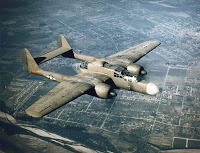 70 Years Ago—May 21, 1942: Japanese land in Leyte Gulf in Philippines. First flight of Northrop P-61 Black Widow nightfighter.
70 Years Ago—May 21, 1942: Japanese land in Leyte Gulf in Philippines. First flight of Northrop P-61 Black Widow nightfighter.
Published on May 21, 2012 03:00
May 20, 2012
Today in World War II History
70 Years Ago—May 20, 1942: Gen. Joseph Stilwell arrives in Imphal, India from Burma with 100 military personnel and civilians, including missionary Dr. Gordon Seagrave and 19 nurses, after 150-mile march. Last Japanese-Americans evacuated from San Francisco.
Published on May 20, 2012 03:00
May 19, 2012
Today in World War II History
70 Years Ago—May 19, 1942: New York City discontinues night baseball games for the duration.
Published on May 19, 2012 03:00
May 18, 2012
Today in World War II History
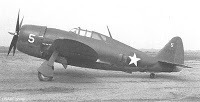 70 Years Ago—May 18, 1942: First deliveries of P-47B Thunderbolt fighter planes to US Army Air Force (doesn’t see combat until 4/43).
70 Years Ago—May 18, 1942: First deliveries of P-47B Thunderbolt fighter planes to US Army Air Force (doesn’t see combat until 4/43).
Published on May 18, 2012 03:00
May 17, 2012
Today in World War II History
70 Years Ago—May 17, 1942: Germans counterattack near Kharkov, ending Soviet advance in the Ukraine.[image error]
Published on May 17, 2012 03:00



